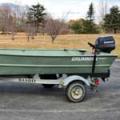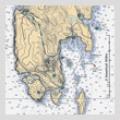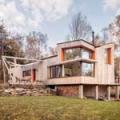From Maine to the Arctic
Story & photographs by Polly Saltonstall
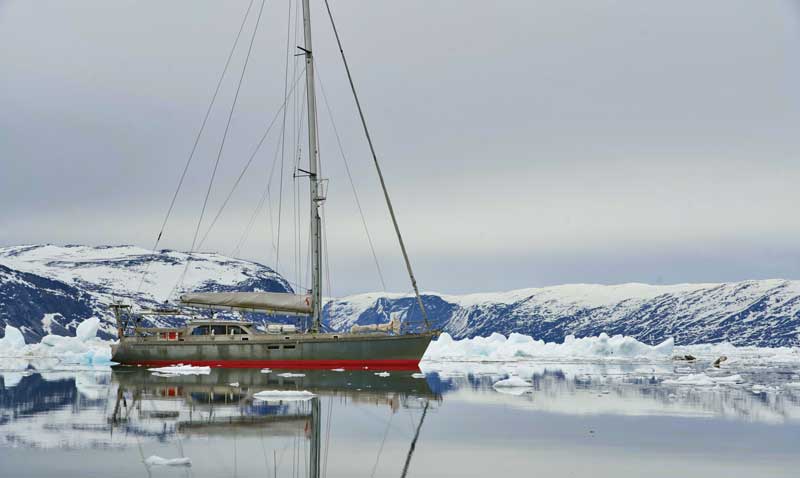 ArcticEarth passes by icebergs that have calved off the Eqip Glacier in Greenland. The aluminum-hulled vessel has been set up as a research platform to help gain a better understanding of the effects of climate change.
ArcticEarth passes by icebergs that have calved off the Eqip Glacier in Greenland. The aluminum-hulled vessel has been set up as a research platform to help gain a better understanding of the effects of climate change.
Several days into a cruise along the West Greenland coast, the 56-foot sloop ArcticEarth was anchored at the head of a small fjord, framed by a line of snow-covered mountains on one side and a ridge of smooth lichen-covered granite and brown gneiss on the other.
As we sat in the cockpit enjoying our morning coffee in the unexpectedly warm sun, the vessel’s captain, Magnus Day, noticed small creatures floating by in the clear green water off our stern. Reaching for a plexiglass container, he scooped down with a splash, capturing several spinning black pteropods the size of thumbtacks—Day called them sea devils—and a tiny pink-veined comb jelly that he identified as a ctenophore. He quickly swung into action, enlisting his wife, first mate Julia Prinselaar, to collect samples of the little creatures to send to scientists who have been using ArcticEarth as a platform for compiling an ocean genome atlas. Co-led by a neuroscientist at the University of Florida, the group is studying convergent evolution through sampling plankton and ctenophores. This year was their second on board ArcticEarth.
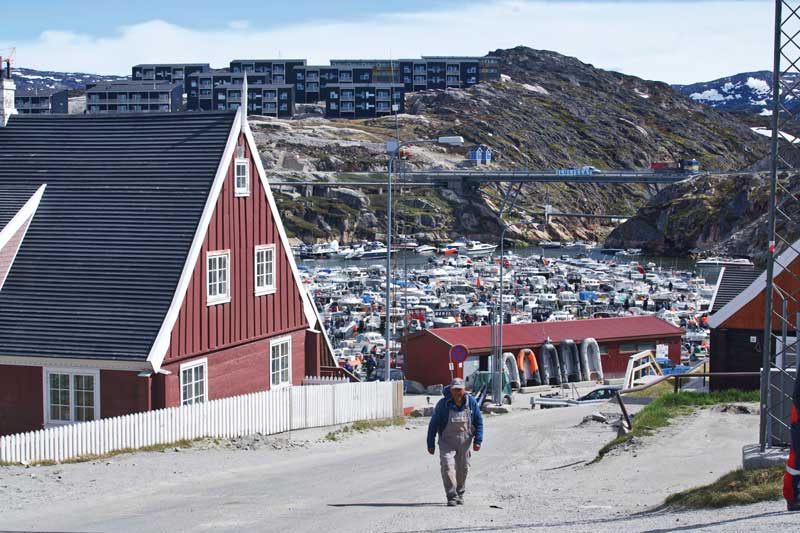 With a population of about 5,000, Ilulissat is Greenland’s third largest town. In addition to its growing tourism industry, the town’s protected harbor is home to a large fleet of small fishing boats.
Research like this is exactly what Camden, Maine-based documentary filmmaker David Conover hoped for four years ago when he bought the aluminum-hulled vessel and had it refitted for expeditions above the Arctic Circle.
With a population of about 5,000, Ilulissat is Greenland’s third largest town. In addition to its growing tourism industry, the town’s protected harbor is home to a large fleet of small fishing boats.
Research like this is exactly what Camden, Maine-based documentary filmmaker David Conover hoped for four years ago when he bought the aluminum-hulled vessel and had it refitted for expeditions above the Arctic Circle.
“I’ve worked a lot in the north as a filmmaker, and I knew it was a place that was a really interesting window, not only into local issues and landscape, but also into what’s happening with the planet as a whole because of the changes happening there much faster than anywhere else,” he said.
So much coverage of climate change mentions Greenland’s melting ice sheet, he explained, but leaves out the specifics of what that looks like in small fjords like this one.
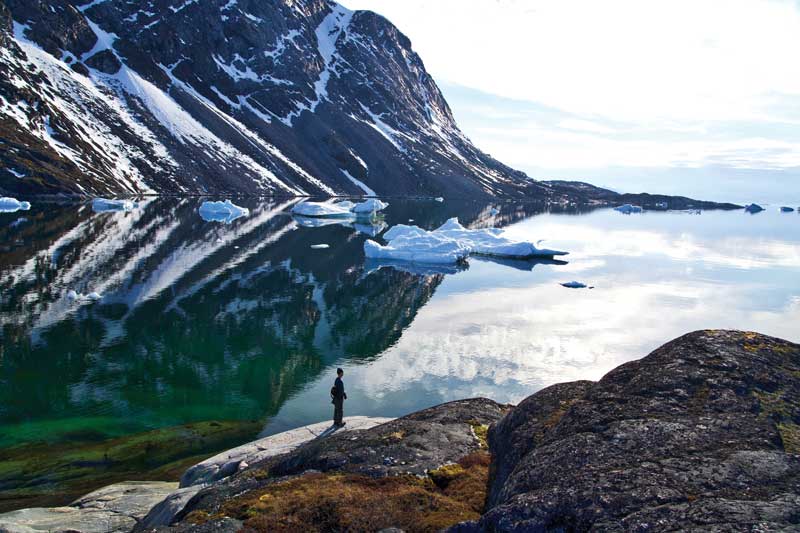 Disko Bay on the west coast of Greenland is dotted with small fjords and inlets like this one.
“I wanted a platform where I could move along the coast with eyes and ears open to see what stories were percolating from the ground up,” he said. “Really the main thing for me is the importance of being there.”
Disko Bay on the west coast of Greenland is dotted with small fjords and inlets like this one.
“I wanted a platform where I could move along the coast with eyes and ears open to see what stories were percolating from the ground up,” he said. “Really the main thing for me is the importance of being there.”
Especially appealing to Conover is the idea of using the boat, which can sleep up to eight people including two crew, as a platform for multiyear research, as well as for storytelling, by him and others. ArcticEarth is available for charter at much more affordable rates than the traditional large Arctic research vessels, he noted.
On this trip, my husband, son, and I were on board with marine photographer Alison Langley as part of ArcticEarth’s mission as a platform for storytelling. While learning about photography, we also explored remote ghost villages, fjords, and the coastal terrain, observing the magic and science of the Arctic landscape.
 Most of the fishermen in Ilulissat use small outboard runabouts like this one to fish for shrimp and halibut. On one of the days the author was there, an emergency call went out about a boat with no one aboard. The body was not found.
With Camden its home port, the vessel was designed by Camden-based naval architect Ed Joy specifically for Arctic expeditions. Built at Jacobs Bros. Boat Builders in Cape Town, South Africa, and launched in 2016, the vessel’s swing rudder and keel give it a draft of 8 feet, 9 inches with the keel down but allow it to sneak into shallow harbors with a draft of 3 feet, 2 inches with the keel and rudder up.
Most of the fishermen in Ilulissat use small outboard runabouts like this one to fish for shrimp and halibut. On one of the days the author was there, an emergency call went out about a boat with no one aboard. The body was not found.
With Camden its home port, the vessel was designed by Camden-based naval architect Ed Joy specifically for Arctic expeditions. Built at Jacobs Bros. Boat Builders in Cape Town, South Africa, and launched in 2016, the vessel’s swing rudder and keel give it a draft of 8 feet, 9 inches with the keel down but allow it to sneak into shallow harbors with a draft of 3 feet, 2 inches with the keel and rudder up.
The open saloon has 360-degree views—allowing passengers to enjoy the scenery without braving the chilly elements. For those who wish to explore in a small boat, an outboard-powered RIB can be launched from the foredeck. The transom has a wide platform for small-boat access, scuba diving, or swimming.
 The author on a swim above the Arctic Circle.
My son and I used the platform and tested the water with brief dips near the Eqip Glacier, located at 69 degrees, 47 minutes north latitude. The water temperature was 30 degrees F and we got out fast, thanks to the sturdy dive ladder. Luckily, we were able to warm up quickly in ArcticEarth’s hot shower and in the cozy heated living spaces, which include a spacious galley.
The author on a swim above the Arctic Circle.
My son and I used the platform and tested the water with brief dips near the Eqip Glacier, located at 69 degrees, 47 minutes north latitude. The water temperature was 30 degrees F and we got out fast, thanks to the sturdy dive ladder. Luckily, we were able to warm up quickly in ArcticEarth’s hot shower and in the cozy heated living spaces, which include a spacious galley.
When he bought the boat, Conover committed to using it for at least five years of research in the Arctic and Gulf of Maine. Now in its fourth year, ArcticEarth has been busy.
In addition to the Ocean Genome Atlas project, others using the boat as a scientific platform include a group from the University of Maine Climate Change Institute, who are taking salt and fresh water samples along the west coast of Greenland to understand the extent of local pollution from contaminants such as PFAs.
The group scheduled to be on board after us, including Conover, planned to document the Maine Maritime Academy’s 103-year-old sailing vessel Bowdoin—the oldest active Arctic research vessel and the official sailing vessel of the State of Maine—on its 30th cruise north of the Arctic Circle. Later in the summer, ArcticEarth was scheduled to sail around the bottom tip of Greenland and up the island’s east coast with groups of photographers and writers.
For our cruise, we sailed along the coast in Disko Bay, dodging icebergs that came in so many shapes and sizes—like clouds, except not in the sky. One might look like a bear, another a beaked bird. On the horizon, rows of rectangular bergs looked like big tankers heading out to sea. Some that had recently rolled over had complex, lined, and pocked contours, while others, tabular bergs, more recently calved from the glacier, featured flat, snow-covered tops. According to National Geographic, the life span of an iceberg from first snow to final melt is as long as 3,000 years—watching them is like watching real dinosaurs.
Up close, we could see the bergs’ massive underbodies glowing turquoise. Less than a quarter of an iceberg is actually above water; the rest is submerged. As the ice under water melts, it releases oxygen that bubbles up to the surface. The increasingly dense part remaining absorbs the reds and yellows in the color spectrum, leaving the greens and blues that we see.
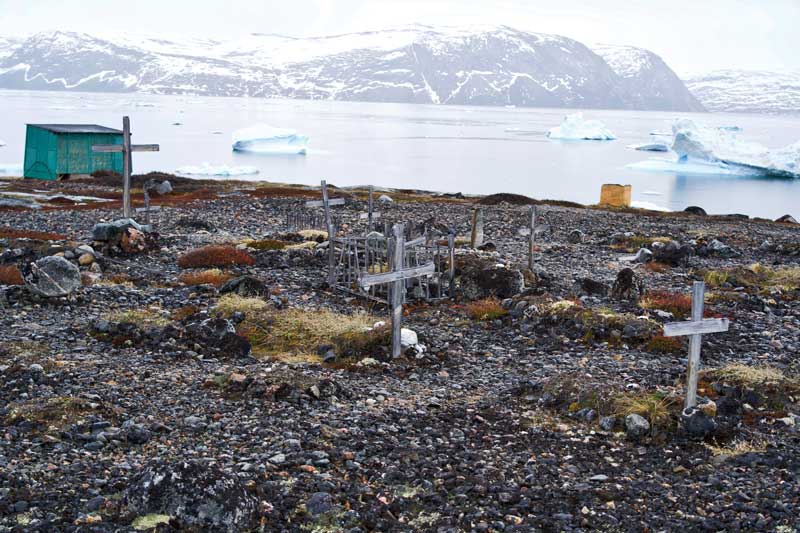 Small graveyards with worn wooden crosses and faded stones like these these in the abandoned settlement of Ataa are a poignant sight. One of the gravestones at this site memorialized an individual who died in 1891.
Eventually, when enough of the underside has melted, the bergs crack apart with loud booms, shedding chunks of ice and creating rolling waves. We watched one calve off our stern one evening while we were at anchor. The force of the split sent the separated pieces careening up and down in the water, like whales diving and then coming back to the surface.
Small graveyards with worn wooden crosses and faded stones like these these in the abandoned settlement of Ataa are a poignant sight. One of the gravestones at this site memorialized an individual who died in 1891.
Eventually, when enough of the underside has melted, the bergs crack apart with loud booms, shedding chunks of ice and creating rolling waves. We watched one calve off our stern one evening while we were at anchor. The force of the split sent the separated pieces careening up and down in the water, like whales diving and then coming back to the surface.
 Mussels harvested in the chilly water at low tide made for a tasty dinner. John Hanson shows off his haul.
During shoreside hikes, we squished through spongy heath, marveling at the delicate tiny pink blooms of trailing azalea, fragrant green-leaved Labrador tea, and many different types of lichen, moss, and other alpine flora. We hiked up rocky ridges toward ice-covered lakes, occasionally stopping to watch birds, including pairs of black-and-white snow buntings, kittiwakes, and Lapland longspurs with their red necks. Once we saw a cawing black raven and its chicks in their nest of twigs high on a cliff. Another time we saw an Arctic fox loping along the shore.
Mussels harvested in the chilly water at low tide made for a tasty dinner. John Hanson shows off his haul.
During shoreside hikes, we squished through spongy heath, marveling at the delicate tiny pink blooms of trailing azalea, fragrant green-leaved Labrador tea, and many different types of lichen, moss, and other alpine flora. We hiked up rocky ridges toward ice-covered lakes, occasionally stopping to watch birds, including pairs of black-and-white snow buntings, kittiwakes, and Lapland longspurs with their red necks. Once we saw a cawing black raven and its chicks in their nest of twigs high on a cliff. Another time we saw an Arctic fox loping along the shore.
Late one night we had to pull up anchor and move the boat as floating pack ice banged against the hull and threatened to strand us in a small cove. At 2 a.m. the Arctic sun shone brightly, casting gold-tinged shadows on the sparkling ice.
During our trip we read accounts of historic Greenland expeditions by such icons as Knud Rasmussen, whose home in Ilulissat is now a museum, and Fridtjof Nansen. My son commented that Greenland historically has been a scientific frontier for understanding our planet’s history. Except that today, he said, the research seems more focused on understanding our effect on the planet’s future. Scientists looking at air bubbles and the concentration of greenhouse gasses in core samples from the ice cap have been able to see climate patterns going back to pre-Roman times. Those patterns in recent years have been increasingly ominous. According to one account, satellite measurements by the Technical University of Denmark have shown that the yearly net loss of Greenland’s ice sheet has quadrupled since the 1990s, causing an estimated 75-millimeter rise in sea levels.
We saw some of the impact of the warming climate first-hand when we wove our way through clusters of icebergs toward the face of the Eqip Glacier. About 5 kilometers wide and 200 meters high, this glacier has been rapidly retreating in recent years, calving off icebergs that float far out into the Atlantic toward Newfoundland and Nova Scotia.
We began and ended our week-long cruise in Ilulissat, a town of about 5,000 at the edge of Disko Bay. Greenland’s third largest town, Ilulissat draws tourists to its ice fjord jammed with massive bergs breaking off the Kujalleq Glacier, the world’s fastest moving glacier. It’s been named a World Heritage site by UNESCO. But the town’s main economy is evident in the protected harbor, filled with small outboard-powered fishing boats whose owners sell their catch of halibut and shrimp at several big processing plants.
On our first day as we walked along the dock, a fisherman gutting a fat speckled wolf fish stopped when he saw us taking photos; with a grin and hand gestures declining payment, he held out a plastic grocery bag full of fresh shrimp. These same tiny Pandalus borealis shrimp once were so plentiful along the Maine coast that fishermen sold them for small change from the back of pickup trucks. But blaming warming ocean waters, New England fisheries managers closed the fishery a decade ago as the shrimp retreated north.
As we ate our shore-side catch that night, I hoped that projects such as those hosted by ArcticEarth can raise awareness about our rapidly changing planet in time to prevent fishermen in places like Ilulissat from suffering the same fate as fishermen in Maine.
✮
Polly Saltonstall is MBH&H’s editor at large.
Related Articles
Share this article:
2023 Maine Boat & Home Show

Join Us for the Maine Boat & Home Show!
Art, Artisans, Food, Fun & Boats, Boats, Boats
August 11 - 13, 2023 | On the waterfront, Rockland, Maine
Click here to pre-order your tickets.
Show is produced by Maine Boats, Homes & Harbors magazine.









